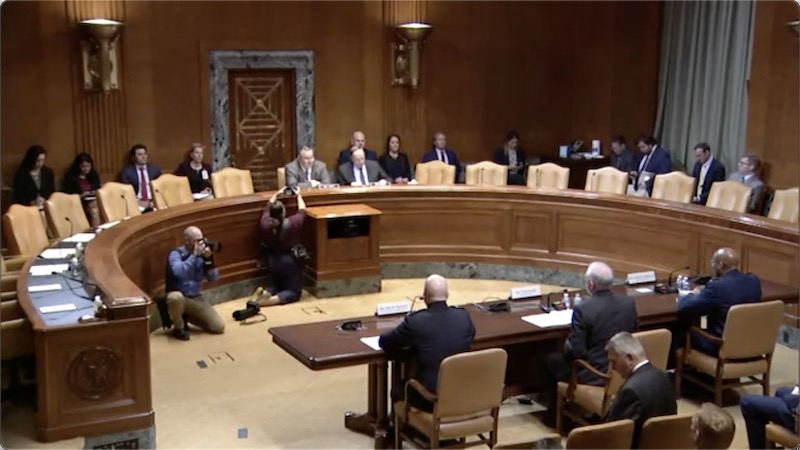导读:针对财年2023预算问题,美国参议院召开了听证会,美国空军部长、空军参谋长、太空部队参谋长三人做了发言,并接受了议员的询问。本文选择美国空军在一体化威慑中的地位和价值,供读者参考和讨论。

空军在一体化威慑方面发挥着独特的作用,作为国家在作战领域、战区和冲突范围内无缝执行的领先和最灵活的选择。空军以安全、可靠和可靠的核威慑力量为后盾,提供一系列可靠的作战能力。作为三分之二的核三合会和四分之三的国家NC3的管家,空军从根本上使国家的核威慑能够实现稳定的国际秩序。与跨机构、盟国和合作伙伴的关系和联系——无论是在印太地区与日本、澳大利亚和大韩民国的关系,还是目前支持北大西洋公约组织的部署——都是一体化威慑的关键要素。在整个联合部队、作战司令部以及盟国和合作伙伴中,空军空中力量的能力被证明是无价的,因为需求始终超过供应。通过集中精力平衡近期风险,空军能够继续支持这些需求,同时加快对未来能力的投资。
核威慑是一体化威慑的重要组成部分。美国的战略威慑为联合部队、盟国和伙伴以及国家安全提供保障,同时威慑其他国家使用核武器。核威慑也可以作为对美国和盟国总体重要利益的其他战略攻击的威慑,并为战略盟友提供重要的保证。作为负责国家大部分核能力的军种,空军的2023财年预算继续进行投资和改进,以维持和加强战略威慑。
能够提供迅速、压倒性的反应,核三合会的地面部分是威慑对手对手的关键能力,并在2023财年预算中全额资助。为了确保这种能力保持就绪,空军正在使用哨兵系统进行现代化改造,即我们的地面战略威慑(GBSD)。随着现有Minuteman III机队老化,我们的节奏挑战正在大力投资以发展和现代化其核武库,因此其准时交付至关重要。中国最近在其西部沙漠建造了100多个新的洲际弹道导弹发射井。与此同时,俄罗斯的核现代化工作已完成80%以上,俄罗斯领导人公开表示近期核力量处于高度戒备状态。美国已经尽可能地推迟了核资本重组,对哨兵综合武器系统的持续投资是绝对必要的。
空军具有核能力的轰炸机部队提供了国家核三合会的第二站。B-21代表了我们轰炸机部队的未来。作为核三合会中最灵活的一条,B-21是一种独特的国家安全能力。该预算包括继续进行工程和制造开发以及对核认证的支持。根据B-21系列系统的定义,为支持作战需求,空军将开发、测试和部署B-21,同时追求引进低成本、互补、无人驾驶飞机的潜力提供更高水平的常规能力。随着空军的现代化,它将继续向能够通过B-21和B-52投送核武器和常规武器的两架轰炸机机队过渡。这些现代化能力将为未来几十年提供全球核打击和常规全球打击选择。
空军必须继续投资于研究、开发、测试和部署具有成本效益的远程传统和高超音速武器。联合空对地防区外导弹-增程导弹以最大生产能力提供资金,远程防区外武器继续开发,为未来的核远程打击提供选择。高超音速空射快速反应武器系统获得资金完成开发;然而,生产资金被推迟到成功的飞行测试发生。联合先进战术导弹(JATM)继续全面发展,而高超音速攻击巡航导弹加速发展。空军必须发展这些革命性的能力和其他先进的武器,以在节奏挑战中保持竞争优势。
空军对NGAD系列系统的追求通过尖端的概念和技术确保了未来的空中优势。对手正在对削弱空军优势的能力进行投资,而NGAD的投资将继续开发先进传感器、弹性通信和飞行器技术。NGAD的系统家族将通过配备灵活组合的武器、传感器、电子战和其他任务系统的载人和无人飞机提供生存、持久和致命的选择,因为它与当前和未来的目标相联系通过ABMS系统。
为了支持一体化威慑,空军将与我们在世界各地的盟友和伙伴合作,以确保我们的集体、联合和综合能力以最有效的方式得到使用。ABMS将提供实现这一目标所需的连通性和协作决策。该预算为基础设施、早期增量能力和先进战斗管理工具提供资金,作为JADC2的空军组成部分。
随着空军为一体化威慑做出贡献,它将与联合部队、盟国和伙伴一起这样做。空军正在广泛开展工作,以确保当前的能力和未来的武器系统最大限度地提高与盟国和合作伙伴的互操作性。空军一直在跨国界建立、重复和强化向战略竞争对手传达的简单信息——稳定的国际秩序的好处远远超过侵略和不稳定。
英文原文:
The Air Force plays a unique role in integrated deterrence as the Nation’s leading and most agile choice for executing seamlessly across warfighting domains, theaters, and spectrums of conflict. The Air Force provides a range of combat-credible capabilities backed by a safe, secure, and reliable nuclear deterrent. As stewards of two-thirds of the nuclear triad and three-fourths of the Nation’s NC3, the Air Force foundationally enables the Nation’s nuclear deterrence for a stable international order. Relationships and connections with the interagency and allies and partners—whether in the Indo-Pacific with Japan, Australia, and the Republic of Korea or as demonstrated by current deployments in support of the North Atlantic Treaty Organization—are critical elements of integrated deterrence. Across the joint force, combatant commands, and allies and partners, Air Force airpower capabilities prove invaluable as demand consistently exceed supply. Through focused efforts to balance near-term risk, the Air Force is able to continue supporting these demands while accelerating investments in future capabilities.
Nuclear deterrence is a significant part of integrated deterrence. The United States’ strategic deterrent provides the joint force, allies and partners, and the Nation security guarantees while deterring other nations’ use of nuclear weapons. The nuclear deterrent can also serve as a deterrent to other strategic attacks on American and allied vital interests in general and provides critical reassurance to strategic allies. As the Service responsible for the majority of the Nation’s nuclear capabilities, the Air Force’s Fiscal Year 2023 budget continues investments and improvements to sustain and reinforce strategic deterrence.
Capable of providing prompt, overwhelming response, the ground-based leg of the nuclear triad is a critical capability for deterring peer adversaries and is fully funded in the Fiscal Year 2023 budget. To ensure this capability remains ready, the Air Force is modernizing with the Sentinel system, our Ground Based Strategic Deterrent (GBSD). Its on-time delivery is critical as the existing Minuteman III fleet ages and our pacing challenge is investing heavily to grow and modernize its nuclear arsenal. The PRC recently built more than 100 new intercontinental ballistic missile silos in its western desert. At the same time, Russia's nuclear modernization efforts are more than 80% complete, and Russian leaders publicly stated the nuclear forces were recently placed on high alert. The United States has delayed nuclear recapitalization as long as possible, and consistent investment in the Sentinel comprehensive weapon system is an absolute necessity.
The Air Force’s nuclear-capable bomber force provides the second leg of the Nation’s nuclear triad. The B-21 Raider represents the future of our bomber force. As the most flexible leg of the nuclear triad, the B-21 is a unique national security capability. This budget includes additions to continue Engineering and Manufacturing Development and support to nuclear certification. In support of the operational imperative, as the B-21 family-of-systems is defined, the Air Force will develop, test, and field the B-21 while pursuing the potential to introduce a lower-cost, complementary, un-crewed aircraft to provide an enhanced level of conventional capability. As the Air Force modernizes, it will continue the transition to a two-bomber fleet capable of nuclear and conventional weapons delivery through the B-21 and B-52. These modernized capabilities will provide global nuclear and conventional global strike options for decades to come.
The Air Force must continue its investment in researching, developing, testing, and fielding cost-effective long-range traditional and hypersonic weapons. The Joint Air-to-Surface Standoff Missile-Extended Range is funded at maximum production capacity, and the Long-Range Standoff Weapon continues in development, providing future nuclear long-range strike options. The hypersonic Air-Launched Rapid Response Weapon system is funded for completion of development; however, production funding is deferred until successful flight tests occur. The Joint Advanced Tactical Missile (JATM) continues in full- scale development, while the Hypersonic Attack Cruise Missile ramps up its development. The Air Force must develop these revolutionary capabilities and other advanced weapons to maintain a competitive advantage over the pacing challenge.
The Air Force’s pursuit of the NGAD family-of-systems ensures air superiority in the future through cutting-edge concepts and technology. Adversaries are investing in capabilities that erode the Air Force’s advantage, and NGAD investments continue development efforts for advanced sensors, resilient communications, and air vehicle technologies. NGAD’s family-of-systems will provide survivable, persistent, and lethal options through a mix of crewed and un-crewed aircraft equipped with a flexible combination of weapons, sensors, electronic warfare, and other mission systems as it links with current and future targeting systems through ABMS.
In support of integrated deterrence, the Air Force will be working with our allies and partners around the world to ensure that our collective, joint, and combined capabilities are used in the most effective way possible. ABMS will provide the connectivity and collaborative decision-making needed to make this possible. The budget funds a mix of foundational infrastructure, early increment capabilities, and advanced battle management tools as the Air Force component of JADC2.
As the Air Force contributes to integrated deterrence, it will do so with the joint force, and allies and partners. The Air Force is working broadly to ensure that current capabilities and future weapons systems maximize interoperability with allies and partners alike. The Air Force is consistently engaged across borders to build, repeat, and reinforce a simple message to strategic competitors—the benefits of a stable international order far outweigh aggression and instability.

评论